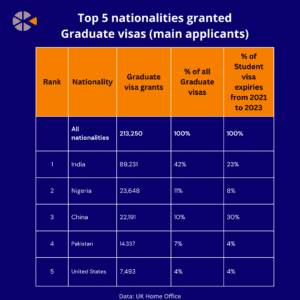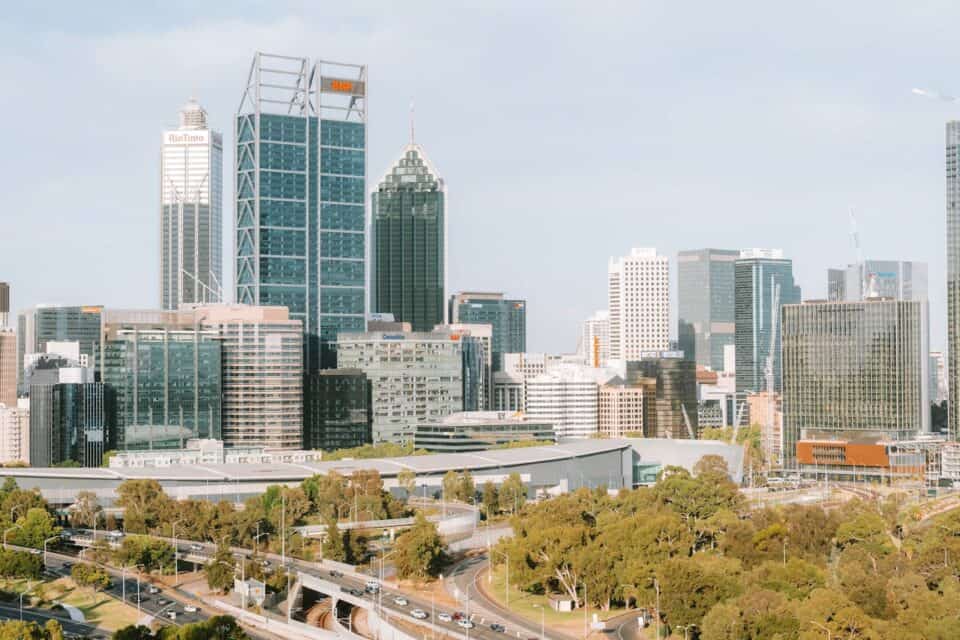Indian nationals account for 42% of all graduate visas issued, as data reveals who is using the Graduate Route, and how they are using it.
On the same day as the Migration Advisory Committee has published the findings of its review into the UK Graduate Route, the Home Office released data analysing the journey of those using it.
The data reveals details of those entering and leaving the route – which was introduced in July 2021 – including where they come from, what they do after their visa expires and early insights into earnings.
However, the Home Office said “it is too early to say whether the behaviours of the early adopters of the scheme will be indicative of the behaviours of later cohorts”.
The proportion of students granted further leave to remain in the UK following their studies more than tripled between 2019 and 2023, from 18% to 56%.
Over half of students – 56% – whose studies concluded in 2023 had further leave to remain in the UK. Most of these students – 32% – used the Graduate Route and 18% went through other work routes.
Some 213,250 main applicants and 45,836 dependants were granted graduate visas between the route’s launch in July 2021 and the end of 2023.

Source: UK Home Office
Analysing the origin countries of main applicants, data found that the top five nationalities account for almost three-quarters (74%) of graduate visas issued, with Indian nationals accounting for 42% of graduate visa grants in 2023.
“Indian students were proportionally more likely to switch to the graduate route, accounting for 42% of graduate visa grants but only 23% of Student visa expiries between 2021 and 2023,” the report read.
Meanwhile, Chinese students were proportionally less likely to switch to the route, accounting for only 10% of graduate visa grants – a total of 22,191 – but 30% of student visa expiries.
Nigeria made up 11% of all graduate visas with a total of 23,648 and those from Pakistan made up 7%, with 14,337 graduate visas issued.
Completing the top five, those from the US made up 4%, with 7,493 graduate visa holders.

Source: UK Home Office
Painting a picture of those entering the Graduate Route by age, the Home Office said that visa holders of the route tend to be in their mid-to-late 20s with more than half – some 58% – between the ages of 24 and 29.
As for what individuals do once their Graduate Route visa ends, 63% of the 25,469 individuals whose graduate visas had expired by the end of 2023 had switched to another route, the data showed.
Some 46% had switched to a work route, with 33% extending into a Skilled Worker visa, 9% into a Skilled Worker – Health and Care visa, and 4% into other work routes.
Only 7% returned to study, 6% switched to a family visa, and 5% switched to other routes.
An additional 17,080 individuals had switched out of the Graduate Route, despite still holding valid leave at the end of 2023. The majority – 12,549 – switched to work routes, including 8,485 into Skilled Worker visas and 3,245 into Skilled Worker – Health and Care visas.
Brian Bell, chair of MAC, pointed out an expectation of fewer students using the graduate route from 2024 since banning dependents from January 2024 had “mechanically reduced” the number of graduate visa holders, “as around 30,000 dependants joined the route in 2023”.
The Home Office data also provided early insights on earnings and employment by linking Home Office visa records to HMRC earnings data.
“Of all graduate visa holders in scope to earn across the whole financial year ending 2023, who were in employment at some point in the financial year, 62% of graduate visa holders were earning in the first month following their visa being granted,” the report read.
“It is too early to say whether the behaviours of the early adopters of the scheme will be indicative of the behaviours of later cohorts”
Meanwhile, 10% started earning in the second month following their visa being granted. This proportion continues to decrease over subsequent months, the Home Office data highlighted.
Since the Graduate Route’s launch in 2021, the median monthly pay gradually rose from £1,227 to £1,937 in 2023.
Analysing how much graduate visa holders earned in the financial year ending 2023, the median annual earning for the 73% of graduate visa holders who were in employment for at least one month was £17,815.
Notably, for the 27% who were in employment across the entire year, the figure was higher at £26,460. Some 46% of those in employment across the entire year earned between £20,000 and £29,999, the data highlighted.
Meanwhile, 41% who earned in at least one month in financial year ending 2023 earned less than £15,000, and some 9% of those who earned for the full year earned less than £15,000.
Of the top given nationalities granted graduate visas, those from the US who worked at least one month had a noticeably higher median annual earning during financial year ending 2023 – a figure sitting at £21,135.
At the other side of the spectrum, those from Pakistan had a much lower median annual earning – £14,402 – a figure not far off those from China – £15,762.
The data also analysed which sectors attracted those on the route, with administrative and support services sector being the most popular with 25% of graduate visa holders.
Meanwhile, 16% went in to the health and social work sectors, followed by 14% to scientific and technical activities.
Graduate visa holders were least likely to be employed in real estate, as well as transportation and storage sectors – each field attracted just 1%.
Those working in finance and insurance earned the most, with this being the sector with the highest annual earning for the financial year ending 2023. The median earning in the field sat at £34,846 for those who earned for the entire year and a lower median amount of £27,879 for those who earned in at least one month.









